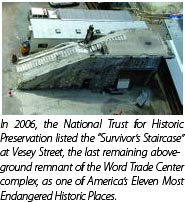Rebuilding Ground Zero
You can’t leave Vassar without being moved by the fineness of the campus’ diverse architecture and landscape architecture, as well as the school’s history, historic associations, and contributions to culture,” says Roberta Lane ’96. She thinks that this might be the reason why so many Vassar alumnae/i are a part of the large effort to help rebuild and revitalize Lower Manhattan after the terrorist attacks nearly six years ago.
As a legal liaison and field representative for the National Trust for Historic Preservation, Lane believes in the importance of preserving buildings and the societies that surround them. “I guess it’s just in the nature of the liberal arts tradition to promote the search for latent value and meaning, as well as activism,” she says.
For years now, much of the nation has followed the story of a memorial to be built on the site of the World Trade Center. What many do not know is that the surrounding areas of Lower Manhattan are still struggling with the effects of the attacks—physically and economically. “For over 300 years, Lower Manhattan has played a vital role in the development of our nation’s social, cultural, economic, and political history,” says Ken Lustbader ’83, a consultant and spokesperson for the Lower Manhattan Emergency Preservation Fund (LMEPF). “Rebuilding the site and revitalizing the surrounding neighborhoods are crucial.”
LMEPF is the combined effort of five separate preservation groups: The National Trust for Historic Preservation, the World Monuments Fund, the Preservation League of New York State, the Municipal Art Society, and the New York Landmarks Conservancy. These groups “recognized that with all the competing civic voices as well as urgent needs, it would be best to have one coordinated message when dealing with historic preservation issues,” says Lustbader. “Working with these groups as one voice has streamlined decisions and made it easier for elected officials, business leaders, and local residents to understand the importance of preservation.”

As senior project manager in the planning, design, and development department at the Lower Manhattan Development Corporation, Daniella Eidelberg LaRocco ’96 worked on revitalizing streetscapes, improving pedestrian and traffic circulation, and making open space and retail enhancements in various surrounding neighborhoods. Although she has since moved on to the planning and design department of New York University, LaRocco thinks revitalizing Lower Manhattan is critical. “There are obvious global and national implications concerning the strength of the country in responding to an internal terrorism attack. For New York, it also proved the resilience and strength of this city,” she says.
“Vassar taught me the importance of an interdisciplinary approach to looking at the world,” Lustbader says. “It taught me how to take disparate elements or themes and weave them together as one narrative. Through my education, I can look at the many layers of competing interests in N.Y.C. and in Lower Manhattan and make the case for preservation—but also balance my preservation interests with those of the local community, business interests, and families affected by the attacks.”
Since September 11, the many organizations working for Lower Manhattan have turned the uncertainty surrounding the future of the once-vital community into hope and progress. As more years pass, Lustbader thinks the situation will only continue to improve. He says, “This unprecedented activity in such a small area is like a domino effect in creating a strong commercial and residential neighborhood that will commemorate the terrorist attacks but move the city and nation forward.”
